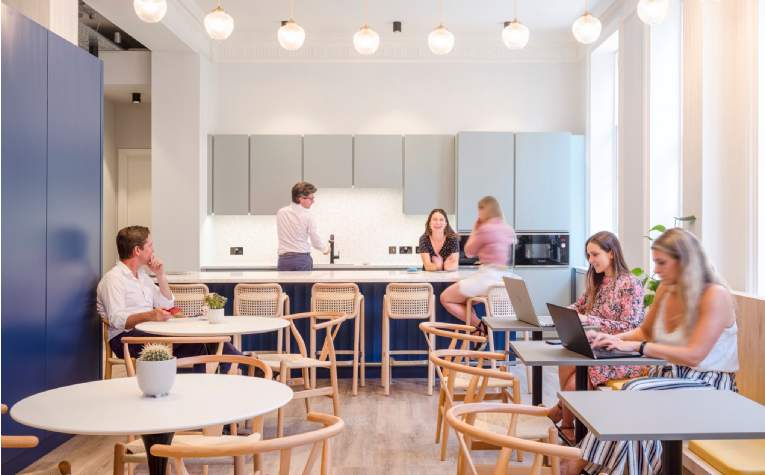Strategic Planning for Neuroinclusive Workplaces
The case for designing a more inclusive workplace for neurodivergent employees is strong. As we outlined in last week’s post, companies stand to gain significantly from the unique skills and talents of the neurodiverse workforce, which continues to experience high unemployment as diagnoses increase. But creating neuroinclusive workspaces requires strategic planning and stakeholder engagement. What are some key strategic considerations for employers prior to designing a neuroinclusive office?
Key Planning Questions
Companies looking to update their workplace strategy over a longer timeline can start the process by asking several key questions to drive decision-making:
Who are your current employees, and how might future recruitment goals impact space?
Knowing your organization’s current employees and future hiring goals is foundational to understanding future space needs. Perhaps your company currently employs neurodivergent individuals with unmet needs at work, or as part of a DEI initiative, the company would like to explore bringing more neurodiverse talent onboard. Identifying the appropriate resources at this stage can help start the process.
There is a growing list of specialist consulting firms that can work with your company to provide essential information about the unique needs of neurodivergent employees in the workplace and creating a more neuroinclusive culture. Recruitment firms that work exclusively with neurodivergent individuals can connect you with neurodiverse talent and help find the right fit for the skillsets you are seeking.
By understanding the make-up of your current and future workforce with respect to neurodiverse talent, you can begin to plan for necessary policy or space changes.
Where are there current unmet needs?
Assessing current unmet needs in the workplace may not always yield a complete picture. It is important to remember that personal health conditions and diagnoses are confidential information that no employee is under any obligation to disclose. Regardless, there are several ways companies can build a more inclusive culture in which neurodivergent employees are empowered to provide feedback on their work environment if they choose.
The bigger picture is creating a foundation in the workplace for dialogue to comfortably take place. This can include an HR-led effort to develop affinity groups within the workplace that give neurodivergent employees centralized resources for sharing, discussing, and advocating for neurodiversity needs. Company-wide education about neurodiversity can help broaden awareness, understanding, and empathy among all employees. Training managers to follow specific processes and protocols if their team members disclose conditions will facilitate more openness and reassurance for employees who choose to discuss needs with their supervisors.
Issuing a confidential survey can help in collecting data on workplace usage and preferences directly. (See “Engagement Process” later in this post.) Re-issuing the survey at regular intervals can help employers keep tabs on evolving needs and preferences.
How will our preferred design strategy accommodate neurodivergent employees?
Perhaps your organization has decided that a shift to an entirely new design strategy is the right long-term move – for example, from a floor plan of private offices and workstations to a more open, activity-based workplace that incorporates a greater variety of focused and collaborative space types. In this case, considering what additional space types may be needed for neurodivergent employees, and how to incorporate them seamlessly into the floor plan, must factor into the overall strategy.
Different design approaches can have a range of impacts on neurodivergent employees. For example, a work environment without assigned seating may pose problems for employees who require a strict routine or a familiar or customized setup from day to day – for example, assistive technology tools or ergonomic accessories. Understanding that one size will not fit all is essential before committing to any design strategy. Building flexibility into a chosen approach – for example, designating limited assigned spaces within an otherwise unassigned floor plan can help accommodate employees who need this.
Is pilot space appropriate for our timeline?
Many companies planning for significant space changes find it useful to run a beta test or pilot program. One survey found that 93% of companies post-pandemic were planning to run pilots to help reconfigure their workspaces. Piloting a new space type can help companies gather usage data that will guide choices on furniture, equipment, and floor plan configurations. It’s a time to experiment, compare, make “safe” mistakes, and then correct them before committing to any major workplace investments on a larger scale.
One of the key advantages of taking the time and space to pilot is the opportunity it provides for employee engagement. Testing new space configurations, or even policies, such as a hybrid work strategy, enables employees to directly experience the change for a period of time and provide feedback. For companies making a first attempt to address neurodiversity needs, this is valuable data to work with.
Engagement Process
Effective strategic planning is based on a thorough engagement process to understand current and future needs. This process touches just about everybody, from company leadership to specific user groups. It can utilize a variety of mediums to gather detailed input that will guide decision making, such as surveys, focus groups, interviews, and visioning sessions. Your workplace strategist can guide you and all relevant groups through this process.
Your workplace strategy team can take steps to ensure that this important data gathering stage is inclusive of neurodivergent employees. For example, a typical survey we would issue might include questions about common environmental sensitivities people with neurodivergent conditions might have. We would issue the survey to all employees or specified user groups. This avoids singling out neurodivergent employees, but it also captures the preferences of neurotypical employees who might have similar needs – such as sensitivity to sound or light.
Another important aspect of the engagement process is bringing stakeholders together in educational workshops. Your workplace strategy team will use workshops to share key data about your company’s work environment as well as workplace research and trends. Targeting leadership in these workshops is key. With 55% of leaders out of touch with their employees’ perceptions, it is an opportunity to share data and trends on the employee experience that leaders are unaware of. This is also the best opportunity in the early planning stages to share knowledge across user groups, such as HR and IT, that can broadly educate stakeholders on potential space needs for neurodivergent employees, cultivating greater awareness and preparedness.
Laying the Foundation for Change
Asking the right strategic questions can help employers build a powerful neuroinclusivity initiative in the workplace. Promoting a neuroinclusive culture ahead of any workplace modifications – by developing support resources, manager training, and staff education – will lay a solid foundation for successful design changes. Leading inclusive engagement processes and investing in pilot programs can help employers gain a clearer vision of what exactly needs to change. With these strategic efforts in place, employers need not fear leaping into the unknown.

(1).png)
-(1)(1).png)
.jpg)

.jpg)
.jpg)

.jpg)
.png)
.png)
(7).jpg)